I am trying to compute the derivative of a neural network with 2 or more hidden layers with respect to its inputs. So not "standard backpropagation" since I am not interested in how the output varies with respect to the weights. And I am not looking to train my network using it (if this warrants removing the backpropagation tag, let me know, but I suspect that what I need is not too different)
The reason for my interest in the derivative here, is that I have a test set which sometimes provides me with a matching [x1, x2] : [y] pair, and sometimes a [x1, x2] : [d(y)/dx1] or [x1, x2] : [d(y)/dx2]. I then use a particle swarm algorithm to train my network.
I like diagrams, so to save a few words here is my network:
and what I would like is for the compute_derivativemethod to return a numpy array of the form below:
This is my attempt so far, but I can't seem to get an array matching my number of inputs at the end. I can't figure what I am doing wrong.
def compute_derivative(self):
"""Computes the network derivative and returns an array with the change in output with respect to each input"""
self.compute_layer_derivative(0)
for l in np.arange(1,self.size):
dl = self.compute_layer_derivative(l)
dprev = self.layers[l-1].derivatives
self.output_derivatives = dl.T.dot(dprev)
return self.output_derivatives
def compute_layer_derivative(self, l_id):
wL = self.layers[l_id].w
zL = self.layers[l_id].output
daL = self.layers[l_id].f(zL, div=1)
daLM = np.repeat(daL,wL.shape[0], axis=0)
self.layers[l_id].derivatives = np.multiply(daLM,wL)
return self.layers[l_id].derivatives
If you want to run the entire code I have made a cut down, commented version, which will work with a copy paste (see below). Thank you for your help !
# -*- coding: utf-8 -*-
import numpy as np
def sigmoid(x, div = 0):
if div == 1: #first derivative f'
return np.exp(-x) / (1. + np.exp(-x))**2.
if div == 2: # second derivative f''
return - np.exp(x) * (np.exp(x) - 1) / (1. + np.exp(x))**3.
return 1. / (1. + np.exp(-x)) # f
def linear(x, div = 0):
if div == 1: #first derivative f'
return np.full(x.shape,1)
if div > 2: # second derivative f''
return np.zeros(x.shape)
return x # f
class Layer():
def __init__(self, in_n, h_n, activation, bias = True, debug = False):
self.w = 2*np.random.random((in_n, h_n)) - 1 # synaptic weights with 0 mean
self.f = activation
self.output = None
self.activation = None
self.derivatives = np.array([[None for i in range(in_n+1)]]) #+1 for global dev
if bias:
self.b = 2*np.random.random((1, h_n)) - 1
else:
self.b = None
if debug:
self.w = np.full((in_n, h_n), 1.)
if self.b is not None: self.b = np.full((1, h_n), 1.)
def compute(self, inputs):
if self.w.shape[0] != inputs.shape[1]:
raise ValueError("Inputs dimensions do not match test data dim.")
if self.b is None:
self.output = np.dot(inputs, self.w)
else:
self.output = np.dot(inputs, self.w) + self.b
self.activation = self.f(self.output)
class NeuralNetwork():
def __init__(self, nb_layers, in_NN, h_density, out_NN, debug = False):
self.debug = debug
self.layers = []
self.size = nb_layers+1
self.output_derivatives = None
self.output = None
self.in_N = in_NN
self.out_N = out_NN
if debug:
print("Input Layer with {} inputs.".format(in_NN))
#create hidden layers
current_inputs = in_NN
for l in range(self.size - 1):
self.layers.append(Layer(current_inputs, h_density, sigmoid, debug = debug))
current_inputs = h_density
if debug:
print("Hidden Layer {} with {} inputs and {} neurons.".format(l+1, self.layers[l].w.shape[0], self.layers[l].w.shape[1]))
#creat output layer
self.layers.append(Layer(current_inputs, out_NN, linear, bias=False, debug = debug))
if debug:
print("Output Layer with {} inputs and {} outputs.".format(self.layers[-1].w.shape[0], self.layers[-1].w.shape[1]))
#print("with w: {}".format(self.layers[l].w))
print("ANN size = {}, with {} Layers\n\n".format( self.size, len(self.layers)))
def compute(self, point):
curr_inputs = point
for l in range(self.size):
self.layers[l].compute(curr_inputs)
curr_inputs = self.layers[l].activation
self.output = curr_inputs
if self.debug: print("ANN output: ",curr_inputs)
return self.output
def compute_derivative(self, order, point):
""" If the network has not been computed, compute it before getting
the derivative. This might be a bit expensive..."""
if self.layers[self.size-1].output is None:
self.compute(point)
#Compute output layer total derivative
self.compute_layer_derivative(self.size-1, order)
self.output_derivatives = self.get_partial_derivatives_to_outputs(self.size-1)
print(self.output_derivatives)
for l in np.arange(1,self.size):
l = self.size-1 - l
self.compute_layer_derivative(l, order)
if l > 0: #if we are not at first hidden layer compute the total derivative
self.output_derivatives *= self.get_total_derivative_to_inputs(l)
else:# get the each output derivative with respect to each input
backprop_dev_to_outs = np.repeat(np.matrix(self.output_derivatives),self.in_N, axis=0).T
dev_to_inputs = np.repeat(np.matrix(self.get_partial_derivatives_to_inputs(l)).T,self.out_N, axis=1).T
self.output_derivatives = np.multiply(backprop_dev_to_outs, dev_to_inputs)
if self.debug: print("output derivatives: ",self.output_derivatives)
return self.output_derivatives
def get_total_derivative(self,l_id):
return np.sum(self.get_partial_derivatives_to_inputs(l_id))
def get_total_derivative_to_inputs(self,l_id):
return np.sum(self.get_partial_derivatives_to_inputs(l_id))
def get_partial_derivatives_to_inputs(self,l_id):
return np.sum(self.layers[l_id].derivatives, axis=1)
def get_partial_derivatives_to_outputs(self,l_id):
return np.sum(self.layers[l_id].derivatives, axis=0)
def compute_layer_derivative(self, l_id, order):
if self.debug: print("\n\ncurrent layer is ", l_id)
wL = self.layers[l_id].w
zL = self.layers[l_id].output
daL = self.layers[l_id].f(zL, order)
daLM = np.repeat(daL,wL.shape[0], axis=0)
self.layers[l_id].derivatives = np.multiply(daLM,wL)
if self.debug:
print("L_id: {}, a_f: {}".format(l_id, self.layers[l_id].f))
print("L_id: {}, dev: {}".format(l_id, self.get_total_derivative_to_inputs(l_id)))
return self.layers[l_id].derivatives
#nb_layers, in_NN, h_density, out_NN, debug = False
nn = NeuralNetwork(1,2,2,1, debug= True)
nn.compute(np.array([[1,1]]))# head value
nn.compute_derivative(1,np.array([[1,1]])) #first derivative
EDITED ANSWER BASED ON SIRGUY's REPLY:
# Here we assume that the layer has sigmoid activation
def Jacobian(x = np.array([[1,1]]), w = np.array([[1,1],[1,1]]), b = np.array([[1,1]])):
return sigmoid_d(x.dot(w) + b) * w # J(S, x)
In the case of a network with 2 hidden layers with sigmoid activation and one output layer with sigmoid activation (so that we can just use the same function as above) we have:
J_L1 = Jacobian(x = np.array([[1,1]])) # where [1,1] are the inputs of to the network (i.e. values of the neuron in the input layer)
J_L2 = Jacobian(x = np.array([[3,3]])) # where [3,3] are the neuron values of layer 1 before activation
# in the output layer the weights and biases are adjusted as there is 1 neuron rather than 2
J_Lout = Jacobian(x = np.array([[2.90514825, 2.90514825]]), w = np.array([[1],[1]]), b = np.array([[1]]))# where [2.905,2.905] are the neuron values of layer 2 before activation
J_out_to_in = J_Lout.T.dot(J_L2).dot(J_L1)

